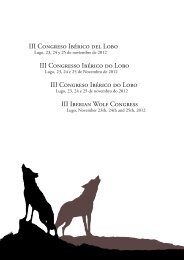Bison-Rewilding-Plan-2014
Bison-Rewilding-Plan-2014
Bison-Rewilding-Plan-2014
- No tags were found...
Create successful ePaper yourself
Turn your PDF publications into a flip-book with our unique Google optimized e-Paper software.
4. <strong>Bison</strong> released into populationsliving in the wildDuring the pre-release phase the bison are monitoredclosely. Initially the monitoring is focused mainlyon the acclimatisation to the local environment, thenew social structure, the food intake and generalhealth status. Once released into the rewildingzone additionally the bison will be monitored onits behaviour among its herd members but alsotowards humans. If one or more of the bison showsunwanted behaviour (e.g. no flight behaviourtowards humans), has problems with adapting to thewild conditions, has a poor health status or does notfit socially in the herd then this or these bison will beexcluded for release into the wild.The decision to release the bison into the wildbased on these criteria will be taken by the localteam in consultation with the wildlife advisor of<strong>Rewilding</strong> Europe.If animals become ill during the whole pre-releasephase they will be treated accordingly andmaximum effort will be taken to cure the animals.Therefore the handling area is constructed.The herd is fit to be released into the wild, if theherd has well recovered and adapted to the localconditions, has a strong herd bonding, show goodnatural behaviour and the animals are all in goodhealth. Usually, the expected adaptation time will be± 6 months. Once released into the wild, the animalswill, in general, no longer be veterinary treated.5. Other activities important to bisonmanagement and reintroduction5.1<strong>Bison</strong> management and monitoringThe optimum time to release bison into thesemi-wild reserve or into the wild is at the beginningof the growing season so that there is maximumfood available, although some prefer to releasebison in the winter (personal communicationPerzanowski, 2003), as this can limit bison distributiondue to snow cover. However, when using thesoft release method release into the wild is best donein the late summer/early autumn as this has giventhe animals the whole summer to adapt and fattenup under controlled conditions and gives themenough time to adapt to the local conditions, andliving without human support, before the wintersets in. With this method high management costs,to feed the animals through the winter are avoided.Monitoring will be an essential componentof bison releases from the outset, not only tocheck the overall health of the population, butalso to ensure social bonding and cohesion ofthe group, particularly as individuals may havediverse origins and be unfamiliar with one otheron arrival to the overall rewilding area. <strong>Bison</strong>should therefore first be monitored in the acclimatisationzone and only when they are deemedto have recovered from transport stress, adaptedto their surroundings (including electric fencing),and display good social bonding will the group bereleased into the semi-wild reserve.In the semi-wild reserve area it will then beimportant to monitor the animals selected forrelease into the wild. Direct observations will beused to study the behaviour of the herds, and thefinal release strategy can be adapted based onthis information. As direct observation is likely tobe time-consuming, close co-operative workingwith will be achieved with universities offeringstudents the opportunity to work closely withbison. Involving many people with monitoringand research not only offers the opportunity toclosely monitor the bison but also involves manyothers in bison conservation. Several individualswithin the first release groups will be equippedwith transmitters or transponders for satelliteand/or radio-telemetry. This will help keep track ofthe bison and will help collect information on howthe bison adapt to their new environment.Poaching and illegal hunting may also be an issuein wild areas and therefore monitoring systemswill be important for effective anti-poachingmanagement. As such, recruiting bison rangersfrom among local people is preferred. The ability tolocate individual bison can also aid wildlife tourism.60



